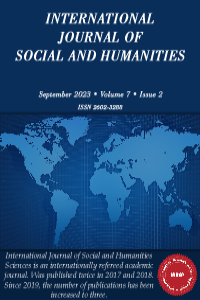Öz
Kaynakça
- Abdy D, C (1925). Notes on Utani and Other Bondei Customs. Royal Anthropological Institute of Great Britain and Ireland Vol. 24: 152-154.
- Bellman, B. L (1975. The village of cures and Assassins: on the Production of Fala Kpelle cosmological Categories. The Hague: Mouton
- Brown, A. R (1940). On Joking Relationships. Africa, xviii: 195-210
- Clerk P. (1999). Digo Settlement in Tanzania and the Kaya Question. Azania: Archaeological Research in Africa 34(1):109-113.
- Dale. G (1896) An Account of the Principle Customs and Habits of the Natives Inhabiting the Bonde Country. The Journal of Anthropological Institute of Great Britain and Ireland vol. 25:181-239
- Gulliver,P (1957). A tribal Map of Tanganyika. Tanganyika Notes and Records,52:61-74
- Kayamba, M (1947). Notes on the Wadigo. Tanganyika Notes and Records 23:80-86.
- Kyando, A.S(1973). The Kinga, URT Vol. 2, Dar es Salam University Press.
- Mgakanzi, M. (2010), The Basuta Jokes, Aera Kiswahili Researched Product, Dar es Salam.
- Mitchell, L. J (1956). The Kalela Dance. Rodes-Livingstone Paper no, 27
- Mikidady M.M (2022). A Century of Identity and History of the Bondei People. MA Thesis. Muslim University of Morogoro
- Mwanuke. R (1965). Neighborhood and Reciprocal Friendship. London: McMillan
- Ngure, A. (2003) Fasihi simulizi, Phonex Publishers, Nairobi
- Pedler,F. (1940).Joking Relationships in East Africa.Africa, Xiii:170-173
- Sengo, T.Y & Lucas, S (1975). Utani na Jamii Ukwere, Foundation books LTD, Nairobi.
- Willis, J (1992). The Making of a Tribe: Bondei Identities and Histories. Journal of African History, 33. (2): 191-208.
- Woodward, H.W (1925). Bondei Folktales 1. Folklore, 136 (2):178-185.
- An interview with Madunda(91) held at Mtonga in muheza- Tanga on 3rd March 2022
- An interview with Asha Mpapai (74) held at Mpapai- Muheza on 5thMarch 2022
- An interview with Mama Nyerere (103) held at Kwe mkuna- Muheza on 7th March 2022
- An interview with Mashaka (63) held at Kivindo on 5th March 2022,
- An interview with Mwanahamisi1 (62) held at Mamboleo on 4rd march 2022
- An interview with Salimu(76) at Paramba-Muheza on7th March 2022.
Öz
Utani and burial traditions are the very common practices in the current Bondei community. The traditions have been in practice since the formation of the society. In this study the two traditions are used in attempt to understand the identity of Bondei people. Burial customs of the Bondei has been in constant transformation. In the beginning clan identities played a significant role in attracting people of other clans to come and mourn together. The burial of unidentified stranger was not considered important and may be carried out only by the clan they visit. Burials involved other traditions major identified is Utani. curing witches was another context where Utani was practiced. Convenient with other traditions, Utani was held predominantly in a forty day from the burial date. The purpose of Utani was to create friendship and comfort the clan which relative has died. The coming of world religions probably around 1850s affected the way burial traditions were to be carried out. Islamic and Christian burial cultures were to be followed parallel with the indigenous traditions.
Kaynakça
- Abdy D, C (1925). Notes on Utani and Other Bondei Customs. Royal Anthropological Institute of Great Britain and Ireland Vol. 24: 152-154.
- Bellman, B. L (1975. The village of cures and Assassins: on the Production of Fala Kpelle cosmological Categories. The Hague: Mouton
- Brown, A. R (1940). On Joking Relationships. Africa, xviii: 195-210
- Clerk P. (1999). Digo Settlement in Tanzania and the Kaya Question. Azania: Archaeological Research in Africa 34(1):109-113.
- Dale. G (1896) An Account of the Principle Customs and Habits of the Natives Inhabiting the Bonde Country. The Journal of Anthropological Institute of Great Britain and Ireland vol. 25:181-239
- Gulliver,P (1957). A tribal Map of Tanganyika. Tanganyika Notes and Records,52:61-74
- Kayamba, M (1947). Notes on the Wadigo. Tanganyika Notes and Records 23:80-86.
- Kyando, A.S(1973). The Kinga, URT Vol. 2, Dar es Salam University Press.
- Mgakanzi, M. (2010), The Basuta Jokes, Aera Kiswahili Researched Product, Dar es Salam.
- Mitchell, L. J (1956). The Kalela Dance. Rodes-Livingstone Paper no, 27
- Mikidady M.M (2022). A Century of Identity and History of the Bondei People. MA Thesis. Muslim University of Morogoro
- Mwanuke. R (1965). Neighborhood and Reciprocal Friendship. London: McMillan
- Ngure, A. (2003) Fasihi simulizi, Phonex Publishers, Nairobi
- Pedler,F. (1940).Joking Relationships in East Africa.Africa, Xiii:170-173
- Sengo, T.Y & Lucas, S (1975). Utani na Jamii Ukwere, Foundation books LTD, Nairobi.
- Willis, J (1992). The Making of a Tribe: Bondei Identities and Histories. Journal of African History, 33. (2): 191-208.
- Woodward, H.W (1925). Bondei Folktales 1. Folklore, 136 (2):178-185.
- An interview with Madunda(91) held at Mtonga in muheza- Tanga on 3rd March 2022
- An interview with Asha Mpapai (74) held at Mpapai- Muheza on 5thMarch 2022
- An interview with Mama Nyerere (103) held at Kwe mkuna- Muheza on 7th March 2022
- An interview with Mashaka (63) held at Kivindo on 5th March 2022,
- An interview with Mwanahamisi1 (62) held at Mamboleo on 4rd march 2022
- An interview with Salimu(76) at Paramba-Muheza on7th March 2022.
Ayrıntılar
| Birincil Dil | İngilizce |
|---|---|
| Konular | Sosyoloji (Diğer) |
| Bölüm | Araştırma Makalesi |
| Yazarlar | |
| Yayımlanma Tarihi | 30 Eylül 2023 |
| Yayımlandığı Sayı | Yıl 2023 Cilt: 7 Sayı: 2 |


